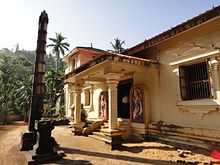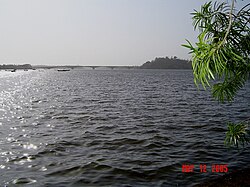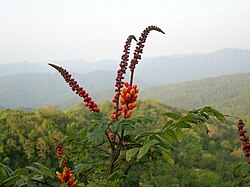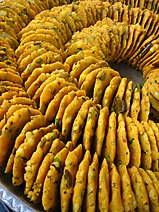Uttara Kannada
Uttara Kannada/North Canara District | |
|---|---|
UTC+5:30 (IST) | |
| PIN | 581xxx |
| Telephone code | +91 0(838x) |
| ISO 3166 code | IN-KA |
| Vehicle registration | |
| Coastline | 142 kilometres (88 mi) |
| Literacy | 84.06% |
Precipitation | 2,835 millimetres (111.6 in) |
| Avg. summer temperature | 33 °C (91 °F) |
| Avg. winter temperature | 20 °C (68 °F) |
| Website | uttarakannada |
Uttara Kannada is a district in the
Karwar is the district headquarters, Kumta and Sirsi are the major commercial centers in the district.
The district's agroclimatic divisions include the coastal plain (consisting of Karwar, Ankola, Kumta, Honnavar and Bhatkal taluks) and Malenadu (consisting of Sirsi, Siddapur, Yellapur, Haliyal, Joida, and Mundgod taluks).
History



The first known dynasty from Uttara Kannada District are
After India's independence in 1947, Bombay Presidency was reconstituted as Bombay State. In 1956, the southern portion of Bombay State was added to Mysore State, which was renamed Karnataka in 1972.
Significant and picturesque, the Sadashivgad fort of historical importance is now a tourist destination located by the Kali river bridge, which has been built at the confluence of the river and the Arabian Sea. The renowned Bengali poet and Nobel laureate Rabindranath Tagore, who visited Uttara Kannada in 1882, dedicated an entire chapter of his memoirs to this town.[4] The 22-year-old Rabindranath Tagore stayed with his brother, Satyendranath Tagore, who was the district judge in Uttara Kannada. There is a substantial amount of Chardo families in this area as they had migrated due to the persecution of the Portuguese in Goa.
Portuguese
Cintacora, also known as Chittakula, and Sindpur, were
British
In 1638, a rival English trading body, the Courteen Association, established a factory at Uttara Kannada (actually the village named Kadwad, situated 6 kilometres (3.7 mi) eastwards on the banks of the Kali river). It was a trade port frequented by traders from

Kingdom of Mysore
In the Treaty of Mangalore signed in 1784, between Tipu Sultan and the East India Company, one finds reference to Uttara Kannada and Sadashivgad written as Karwar and Sadasewgude respectively.[5]
Bhatkal and Honnavar were the chief ports of Tippu Sultan in the district.
The British Empire
The
Maratha Empire
It became a part of
Geography and climate

The main geographic feature of the district is the
Ecology

The district's high rainfall supports lush forests, which cover approximately 70% of the district. The
The district is also home to patches of
Economy
Uttara Kannada has a Gross Domestic District Product of 530297 Lakh Crores with Karwar and Sirsi being major contributors.sirsi has the highest per capita income in the district at 54850 followed by karwar at 44326, while Bhatkal and Haliyal have the lowest.[6]
Agriculture
The chief crops of the district are rice and
Bhatkal is known for its imported goods markets,[citation needed] which existed even before India's liberalisation.
Commerce and industry
Demographics
| Year | Pop. | ±% p.a. |
|---|---|---|
| 1901 | 454,722 | — |
| 1911 | 430,755 | −0.54% |
| 1921 | 401,928 | −0.69% |
| 1931 | 418,048 | +0.39% |
| 1941 | 441,388 | +0.54% |
| 1951 | 518,062 | +1.61% |
| 1961 | 689,862 | +2.91% |
| 1971 | 849,453 | +2.10% |
| 1981 | 1,073,561 | +2.37% |
| 1991 | 1,220,260 | +1.29% |
| 2001 | 1,353,644 | +1.04% |
| 2011 | 1,437,169 | +0.60% |
| source:[7] | ||
According to the
Religion
The population is predominantly
Language
The main language spoken in this district is Kannada, spoken by 55.34%. Other major languages include Konkani at 18.21%, 11.83% Urdu, 9.52% Marathi and 1.36% Telugu. Marathi speakers are mostly located in Joida and Haliyal taluks in the north and Konkani is in majority in Karwar taluk, although it is spoken throughout the district in lesser numbers. Nawayathi is a Konkani dialect spoken by Nawayath Muslims in Bhatkal and surrounding areas.[12]
Literacy
Total about 10.8 lakh people in the district are
| Rank | Taluk | Literacy |
|---|---|---|
| 1 | Sirsi | 94% |
| 2 | Karwar | 89% |
| 3 | Kumta | 87% |
| 4 | Ankola | 85% |
| 5 | Siddapur | 85% |
| 6 | Honnavar | 84% |
| 7 | Dandeli | 83% |
| 8 | Bhatkal | 83% |
| 9 | Yellapur | 81% |
| 10 | Mundgod | 80% |
| 11 | Joida | 76% |
| 12 | Haliyal | 74% |
Culture

Cuisine

Uttara Kannada is famous for a variety of
The staple diet includes a portion of steamed rice with a vegetable and/or seafood accompaniment. Seafood is immensely popular due to its ease of availability, and is prepared with a lot of local spices. Tea is the most popular beverage and is sometimes supplemented with cardamom or mint to give a distinct flavour.
- Kotte Kadubu: The main ingredients in Kotte Kadubu are jackfruit pulp and jaggery. The batter which is prepared with additional ingredients is put into a container and steamed. This dessert is a local delicacy and is served hot with ghee.
- Holge: These are similar to the sweet equivalents of coconuts.
- Todadevu is a special kind of thin-crust dosa made out of jaggery or sugarcane juice. (Most local desserts of Sirsi have jaggery rather than sugar.)
- Shira: is rice cooked in sugar, ghee, and semolina.
- Karakali: is a special kind of spicy chutney prepared from colocasia leaves.
- Kotte Roti: A form of idli-like preparation, steam cooked in a conical shaped container constructed using jackfruit leaves.
- Patrode : a special dish prepared by steaming stuffed colocasia leaves.
- Neer Dose: A soft thin pancake made of batter of boiled rice, coconut milk and salt.
- Kajmiji
- Koli Kajjaya and Hosagere Kajjaya are made of rice flour and fried in oil is a famous dish often using roti. Often served with thick potato sambar or Nati chicken curry, it is a delicacy among the non-vegetarian communities in Siddapura.
- Banana Buns
- Hanchina Rotti
- Ankola Koli Saaru
- Appe Huli
- Patholi
- Kalali Masala
- Genasle
- Bhatkal Biryani
- Tambli
Transport
Public transport
North West Karnataka Transport Corporation (NWKRTC) is the state transport agency in the district. The NWKRTC covers all towns & villages of the district. There is a good network of public transport which connects the villages to the towns of the district. There are regular intra state services to major cities & towns of the state like Bangalore, Mangalore, Shimoga, Mysore, Hubli-Dharwad & Belgaum. The Kadama Transport buses of neighboring Goa state provides regular service from Karwar to Mangalore and all part of Goa state. Kumta, Bhatkal and Sirsi are the main hubs for public transport which provides services to intra-district & intrastate round the clock.
Many private transport buses also provide services for inter / intra state from the district. Bhatkal is the main sector for private transport in the district. The NH-66 which passes through the district which connects Panvel near Mumbai to Kerala state, many private buses are plying on this Highway which provides inter-intra state services to places like Bombay, Poona, Kolhapore, Belgaum, Panaji, Margao, Udupi, Mangalore, Bangalore, Mysore, Bhatkal, Kasaragod, Cannanore, Calicut etc.
Railways
The following Railways pass through the district:
- .
- Londa to 'Vasco Railway line which passes through Castle Rock
- Castle rock to Dandeli Railway line.
- Hubli -Ankola railway line is proposed to link Karwar port and the northern Karnataka.
- Honnavar -Talaguppa, Shimoga railway line is proposed to link Karwar port and the central part of Karnataka.
- Sirsi -Haveri railway line is proposed to link Malnad region.
- Sirsi- Siddapur-Talaguppa, Shimoga railway line is proposed to link Shimoga.
- RO-RO (Roll on/Roll off) services is provided by .
Ports
Uttara Kannada being one of the coastal district of the Karnataka state has a coast of 120 kilometres (75 mi) has many ports which are used for sea trade, naval base, fishing and other maritime activities.
- Karwar Port is an intermediate sea port the main activities of this port are berthing of ocean going ships, coastal shipping, and fishing jetty. Ship bunkering facility is also available at Karwar port.
- Karwar Airport will be built by the Indian Navy at Alageri village. Naval air base which is part of the Navy's Rs 10,000 crore Phase 2 of Project Seabird
- INS Kadamba is a naval base at Arga village of Karwar which is used exclusively for berthing of naval vessels. A naval ship repair yard (dry docks) is also attached to it.
- Belkeri Port is an anchorage port.
- Tadri Port is a fishing port.
- Kumta Port is a fishing port.
- Honnavar Port is a fishing port.
- Bhatkal Port is a fishing port. It was actually Project Seabird which is now in Karwar, people protest and proposal for withdrawn. There is another fishing port called Tengingundy Port.
The Proposed Hubli-Ankola railway line can be feasible venture for the future developments of the ports in the district, for movement of the cargo, at present roads are only major mode of cargo movement which leads to congestion of the National Highways of the district.
Nearby airports
- Goa International Airport
- Mangalore International Airport
- Hubli Airport
- Belgaum Airport
Tourist places
Uttara Kannada (North Kanara) has many tourist places which cater to different likes of the people. There are many religious places like
Notable personalities
- Major Rama Raghoba Rane, Recipient of the Param Vir Chakra
- Justice Dr. S. R. Nayak, Chief Justice of Karnataka High Court
- Ramakrishna Hegde, two-term Chief Minister of Karnataka
- S. M. Yahya, former Finance Minister of Karnataka
- Dr. Sannappa Parameshwar Gaonkar, Deputy Chief Minister in B. G. Kher's Cabinet of the State of Bombay
- Dr. N. K. Nayak, Professor Emeritus at IIT Bombay
- Anant Nag, actor
- Shankar Nag, actor and director
- Yashwant Chittal
- Shantinath Desai
- Chittani Ramachandra Hegde, Yakshagana artist
- Gurudas Kamat, politician
- Kashinath Naik, Commonwealth medalist
- Major Rama Raghoba Rane, Param Veer Chakra Awardee
- Jayshree Gadkar, Marathi movie actress
- Dinakara Desai
- Santosh Naik, Kannada lyrics writer
- Gourish Kaikini, author and teacher
- Narayan Hosmane
- Jayant Kaikini
- Leena Chandavarkar, actress
- Nandan Nilekani, businessman
- Pandari Bai, actress
- Sundar Nadkarni
- Vilas Sarang
- Keremane Shivarama Hegde, Yakshagana artist
- Mynavathi, Kannada Actress
- R N Shetty, industrialist
- Anuradha Paudwal, singer
- Radhika Pandit, actress
- Deepak Gangadhar,Film Producer, Director, Distributor
References
- ^ a b "District Census 2011: Uttara Kannada" (PDF). Registrar General and Census Commissioner of India. Retrieved 17 February 2012.
- ^ Chandra, Subhash (6 December 2020). "A new page: Reviving a piece of history". The New Indian Express.
- ISBN 978-0-520-24385-9.
- ^ "My Reminiscences by Rabindranath Tagore: Ch. 37: Nature's Revenge – Uttara Kannada in Tagore's memoirs". online-literature.com. Retrieved 16 November 2022.
- ^ "Project South Asia". Archived from the original on 20 July 2008. Retrieved 11 August 2009.
- ^ Karnataka Directorate of Economics and Statistics https://des.kar.nic.in/sites/Conference%20Files/3%20Consolidated%20-%20All%20Articles%20-%20GDDP.pdf
- ^ "Decadal Variation In Population Since 1901". censusindia.gov.in. Retrieved 16 November 2022.
- ^ a b c "District Census Handbook: Uttara Kannada" (PDF). censusindia.gov.in. Registrar General and Census Commissioner of India. 2011.
- ^ US Directorate of Intelligence. "Country Comparison:Population". Archived from the original on 13 June 2007. Retrieved 1 October 2011.
Swaziland 1,436,847
- ^ "2011 Resident Population Data". U. S. Census Bureau. Retrieved 30 September 2011.
Hawaii 1,436,847
- ^ "Table C-01 Population by Religion: Karnataka". censusindia.gov.in. Registrar General and Census Commissioner of India. 2011.
- ^ a b "Table C-16 Population by Mother Tongue: Karnataka". www.censusindia.gov.in. Registrar General and Census Commissioner of India.
- ^ "Enduring art". The Hindu. Chennai, India. 10 June 2004. Archived from the original on 30 August 2004. Retrieved 6 September 2007.
- ^ "yaksha". Encyclopædia Britannica. Retrieved 6 September 2007.
